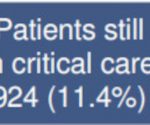Dr Strangelove: or how I learned to stop worrying about the sale of the NHS
There was a lot of talk during the recent election campaign about the NHS being sold off to private companies in a post-Brexit Anglo-American trade deal. If this talk was initiated by Labour (and the author did not pay that much attention to know), then it would undoubtedly have been Tory-bashing intended to trigger “traditional heartlands” to overcome their distaste of the Islington-centric, anti-traditional-heartland, pro-EU Labour parliamentary party, and relegate their highest priority, Brexit, to such an extent that they would in fact risk its not being implemented by creating Corbyn as Prime Minister.
Since the election, there has been a lot of bitterness in the “Lefterati”, both corporate and alternative, that the “traditional heartlands” of one-time Labour voters did not take the bait laid for them – but what the “Lefterati” still do not grasp, in their surprise that there was abandonment of, rather than rallying to Corbyn, is that for many people who might have voted Labour, the NHS isn’t worth the having – not when it has been rendered inaccessible by being open to anyone in the world who can reach British shores. There is no mystery as to why Labour lost the election; it was never meant to win, as the readers of FBEL have been being informed for a long time – and contrary to what the “Lefterati” alternative media would like to believe, vote rigging was not necessary (the only electoral fraud the alternative media won’t get exercised about is those real examples in 2015 when UKIP were cheated out of seats at Westminster).
Anyway, it is due to these recent events that the author thought it was high time to continue a discussion of the NHS further to the FBEL article, The beneficent NHS, where corporate-government makes a buck from population control, which was written two years ago, give or take a day.
The objective is to help disaffected Britons of all political persuasions to understand that the NHS is not even remotely desirable, let alone worth the having. As well as being a sink for wasted wealth, as covered in the aforementioned previous piece, it is a core component of a control grid. It has, after all, a record for every individual since birth, and acquires data whenever an individual engages with it. Furthermore, patients are often surprised with questionnaires about their domestic circumstances unrelated to their predicament; being a patient in itself often produces NHS access to, and therefore monitoring of home life as a consequence of supposedly necessary follow-up to treatment; and less formally, data can be disclosed in conversations during consultation with a GP. However, another aspect of the NHS as control grid component is one less obvious, and will only come from being familiar with the Babylonian origins of technocracy, and the relation of that to what is termed socialism. From such a perspective it can be seen that NHS is a descendent of a device in the apparatus for ancient rule by a priest-king (or by a council of priesthood in conjunction with an individual who is prince over the material world) which works by exploiting Man’s fundamental human condition – and his fear of illness and suffering, and ultimately death.
The ancient Egyptians had a death-industry where concerned individuals would pay the priesthood to chart a route to salvation after death. A “Book of Coming out into the Day” (commonly known as a “Book of the Dead”) was a catalogue of rituals for initiation for the soul; it was a scheme imagining what would be needed to be done, after death, in order to achieve paradise. The individual for whom a book was commissioned, while he remained alive, would be given hope of going to heaven because if the successful completion of after-life trials could be conceived of and written down (or pictorialised), then they could be imagined to have been achieved prior to the time of death. Of course, the Egyptian death-industry was more expansive than that, and it serves to remind that power of the elite isn’t established and maintained merely by having the masses believe in a religious system to uphold an earthly political one; power really does come from extracting and keeping wealth from a populace so that government cannot be challenged. This is the essential element of the art of technocracy that all ancient elites deployed, and is still deployed today.
Nowadays, of course, there isn’t a concept of life after death that is universally understood to be true, and most people, including those who call themselves Christians, would do anything to avoid the so-called promised land. Heaven is no longer available as a means by which to manipulate a population – and perhaps responsible for this is the illusion that people suffer under that there is a good deal of immunity from death due to modern medicine. As such, salvation has become the avoidance of death, rather than the survival of the soul upon death, and in this scenario the priesthood that can save are the doctors. In Britain, that makes the NHS the Temple.
It’s easier to see an equivalence when we trace the development of the ancient business of religion (for power) into the modern business of healthcare – through a crucial stage which was the first century Judaic manifestation of “death-industry” as was know about it from the New Testament. This is not to pick on Judaism – it’s just that it is the ancient religion that we, living in a country that is nominally Christian, know most about. In at least one essential way, it wasn’t typical of ancient religion, but in others it was – and the sustainment of power through manipulation of concern to avoid illness and death was one of these ways.
The reader is asked to remember the example of Jesus healing a leper who is then told to give the required offering at the Temple. This was in keeping with a law regarding a change in condition of a leper, for the disease as it was understood – not necessarily always leprosy, but any illness that caused a change of skin colour or texture – was such that it could clear up, and wasn’t permanent. Cured from leprosy, the one-time sufferer would present themselves to a priest, who would confirm that the person was no longer “unclean” – or at least potentially so, because this would not happen until there was a sacrifice of a bird (in conjunction with other ritual). Then there would be a sacrifice of at least one lamb (depending on the wealth of the person being cleansed), along with a lot of jumping through hoops to give the process the required mystery (as detailed in Leviticus 14).
In the entry on Medicine in the Oxford Companion to the Bible, it states that “Thanksgiving or ‘well-being’ offerings’ (Lev. 7.11-36) after an illness were probably always acceptable and economically advantageous for the Temple”. What this is saying is that the offering for cure from leprosy – and other diseases – translated into wealth and power for the priesthood; and it would be the same case for any service that the priesthood would be required to perform as the only legal interlocutor between an individual and God. People requiring these services would be presented with an option to buy livestock for slaughter at the Temple, and change secular money into sacredly acceptable silver shekels for tribute, which explains the commodities market at Temple that Jesus rebukes. So, here is the establishment of a fact – illness, or the recovery from it, was linked to the wealth, and therefore the power of the ruling class of Biblical Israel. Moreover, the hope of salvation from illness, suffering and death, was provided by adhering to the ritual and ethical code (which was not always legitimately lawful, as Jesus pointed out) that was prescribed by that ruling class: society was conditioned to behave in a manner that enriched and empowered its technocratic leadership. Furthermore, illness would bring about social exclusion as an undesirable, so there was more than the being unwell – such as, one presumes, an ability to conduct business – that would motivate the hope of deliverance by adherence to the political system.
The lynchpin for this manipulation was how people in the society under the Temple priesthood were meant to believe that illness was representative of restitution for sin. Sin was only forgiven by God. When there was healing, it was either with reference to God, and thus legitimate, or it was sorcery, and the work of the devil. Whenever healing was with reference to God, a reason to give thanks at the Temple was elicited. One can see, then, that it was a crucial matter of wealth and power for the ruling class to demonise and criminalise what was essentially a threat to its means to control. The danger of the “sorcerers” was that they had the potential to demonstrate that a cure for illness was unrelated to the authority of the Temple, and that it was of the world and achievable by application of pertinent treatment to an ailment. On the contrary, medicine with reference to God must have been highly ritualistic, because the emphasis was in placating God. Potentially, any healing that occurred might well have been down to good luck – and of course, this would conform to the ancient outlook on the world, where good fortune was an expression of the gods favouring a particular mortal or a group of them.
Given that the New Testament is littered with large crowds of the perpetually ill, and tales of Jesus being inundated by them, we can perhaps assume that healing with reference to God was not routinely successful (how could it be if it wasn’t rooted in science). We should note that Jesus’ success as a healer was the driving force of his popularity – and we would acquire a better understanding of the man, Yeoshua (as opposed to the character, Jesus), if we understood how exactly he was healing – and this is something for a future volume of FBEL’s “Mystery School Christianity” work (to be found on the .co.uk version of this site).
Unlike the healing (or general lack of it) of the New Testament, the concept of healing these days cannot be dislocated from the physical manipulations of a doctor applied to patient, but in a lot of cases, it is still ritualistic according to dogma because there is no institutional appreciation of underlying nutritional causes of illness – which is considered as if a kind of voodoo – and generally no treatment with reference to it. Modern western medicine mostly treats symptoms with drugs, for the good of the pharmaceutical corporations (and its government partner, which provides the demand), rather than the patient. Like the Temple priesthood with its monopoly of legitimate healing, there is a modern orthodoxy, borne out of the desire to sustain vested interests (the wealth and power of the corporate-government), that asserts the ethical supremacy of pharmaceutical medicine. That this is almost universally accepted, because of the conditioning of society, is why there is not the criticism of the motives of the drug pedlars and government that is needed and deserved.
Likewise, modern “health freedom” exponents, who extol that people heal themselves through knowledge of wellness through nutrition, and understanding how the body, at a chemical level, utilises the right sort of food, and suffers from the wrong sort. The “health freedom” healer is very much the sorcerer of first century Palestine (and is given the same kind of repute by the modern orthodoxy) – and the potential of the more natural approach to undermine the power and the wealth of the Temple (these days the NHS) has never gone away.
With the comparisons made, there may be a case to make that the NHS is ultimately like the Temple because of one major reason: it could be argued that where the illness is caused by malnutrition, and this could account for everything except traumatic injury, the NHS never really cures anyone, but only supplies a market for drugs – which often involves extending pharmaceutical-dependent lifespan for a limited time. Even in the case of the flu vaccine, the real prevention is a well maintained (through nourishment) immune system that is made stronger by dealing with variations of the virus that occur naturally; instead populations are made weak by exposure to the manufactured flu that is caused by vaccination. Ultimately, it could be argued that the practice of modern medicine, because it rejects an approach which treats healing as separate from the doings of the higher authority – in this case, medical orthodoxy – is ritual for the show of power (that sometimes gets lucky).
The figures might even suggest the truth of this. In 2018, according to the ONS, there were 616,014 deaths registered in the UK, an increase of 1.5% from 607,172 in 2017 – consider these example numbers for an indication of the typical annual death rate. Between 1st August 2018, and 31st July 2019 (according to data relating to the NHS’ Summary Hospital-level Mortality Indicator [SHMI]), there were 286,000 deaths for the 129 NHS trusts included in the SHMI (apparently, this is English hospitals only, and the figure includes patients who have been discharged to die within 30 days). Roughly it could be said that half the people who die per year, do it in the care of the NHS. Is this a good result? Of course, a counter argument could be that most of these deaths are of people from old age and related illness – however, a proponent of health freedom would say that this sort of death is happening because of a chronic or accumulated problem of nutrition, rather than anything to do with the number of times a person has orbited the sun (which is not in the least bit scientific).
Moreover, while the author has not found out what this means in terms of actual patient numbers, a “key fact” of the SHMI for the period given above is that of 129 NHS trusts, 106 had an expected number of deaths. This appears to suggest that the NHS considers that there is nothing to be done to prevent a particular sort of death that constitutes the vast majority of them. The telling figure is that only 13 trusts had a lower than expected number of deaths (with remaining 10 killing off more than the average) – meaning that not many people were saved when they weren’t expected to be – and again, the notion that death is inevitable from some illnesses is the flawed view of the orthodoxy. So, this is not a performance to be associated with a culture of healing, and from a health freedom perspective, it begins to look like the NHS can perhaps cure a patient when he is nutritionally competent to not suffer from the treatment – or, in other words, the NHS gets lucky when performing ritual – but when this is not the type of supposedly terminally ill patient that the NHS receives in a hospital (and the condition of the patient will be down to the social conditioning of the medical orthodoxy), then all the NHS has is ritual, and that only extends to a certain point because the health care is rationed irrespective of how much the patient has had extorted in taxes. Who wants any of that? The answer is technocratic government, of course – and for the same reason that it has always made health care a matter of religion. And it doesn’t matter that big American pharmaceutical corporations might suddenly have a direct stake in it, because for a individual who wants to be well, and therefore should be seeking after the knowledge of the “sorcerer” for healing oneself, it is undesirable whatever permutation of corporate-government owns it.


















